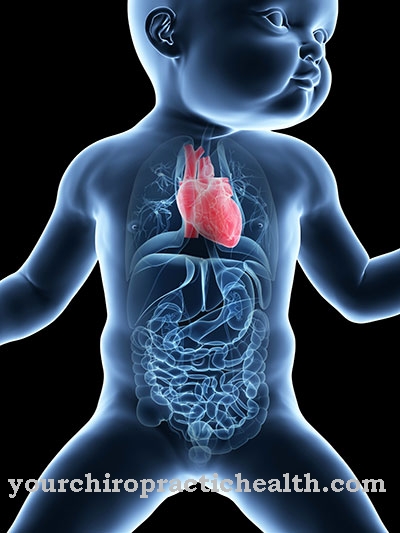Aspergillosis describes a mold infection by Aspergillus species. The sinuses and lungs are often affected by the infection. But other organ systems such as the skin, the gastrointestinal tract or the nervous system can also be affected.
What is Aspergillosis?

© maerzkind - stock.adobe.com
In the case of the infectious disease aspergillosis, the body is attacked by the Aspergillus mold, which is one of the most widespread forms of life in the world. It belongs to the genus of watering cans and hose fungi. The name results from the fact that the reproductive structures of the fungus are characteristic elongated tubes and the shape of the cells is reminiscent of a watering can that is pouring out its contents.
Aspergillosis can cause various clinical pictures. This depends on which organ system is infected by the mold. There are several forms of aspergillosis that are known to include:
- Allergic bronchopulmonary aspergillosis (ABPA): This leads to an allergic reaction of the immune system, which is triggered by the fungal spores in the airways.
- Mycotoxicosis: This disease is due to mycotoxins (mold toxins) poisoning.
- Superficial Aspergillus infection: The infection can affect, for example, the sinuses, the skin of the external auditory canals, and the bronchi and windpipe.
- Invasive aspergillosis: Here, the fungi penetrate deeper into the tissue, so that one or more organs are infected.
In some cases, aspergillosis is also associated with aspergilloma (fungus ball), a larger, spherical colony of mold that develops within a body cavity such as the paranasal sinuses or lungs. A fungal network forms, which usually also contains mucus and dead cells.
causes
Aspergillosis occurs due to an infection with the molds of the genus Aspergillus, more than 90 percent of which are Aspergillus fumigatus. The molds thrive primarily on plant material, in potting soil and on old fruit and vegetables. Infection occurs through inhalation of the mold spores.
They settle in the respiratory tract, from where other organs can be affected. A transmission of aspergillosis from person to person is not possible. Aspergillus fungi are widespread, but not every contact leads to the disease.
The main risk factors include diseases that are associated with a weakened immune system, such as HIV, AIDS, autoimmune diseases and chronic lung conditions. The white blood cells play a very important role in fighting infections such as aspergillosis. A low number of cells, for example from chemotherapy, leukemia or organ transplantation, also makes the body more susceptible to aspergillosis.
The use of certain medications, such as immunosuppressants and cytostatics, and prolonged use of cortisone can also increase the risk. Healthy people who have an intact immune system rarely get aspergillosis.
Symptoms, ailments & signs
The symptoms of aspergillosis vary depending on the type of disease. People with asthma and cystic fibrosis may have an allergic reaction to Aspergillus. The signs include fever, cough, sometimes with phlegm and / or blood, and shortness of breath. But worsening asthma, a mushroom ball (aspergilloma) and fatigue can also occur.
Invasive pulmonary aspergillosis, the most severe form, occurs when the infection spreads rapidly from the lungs to the brain, heart, kidneys, or skin. This mostly occurs in people with a weakened immune system, for example after chemotherapy.
Symptoms include fever, chills, shortness of breath, coughing with expectoration of blood and bleeding from the lungs. Nosebleeds, chest or joint pain, as well as unilateral swelling on the face and skin lesions are also part of the clinical picture.
If aspergillosis occurs in the sinuses, it is noticeable in a blocked nose, fever, inflammation, pain in the face and headache.
Diagnosis & course
Diagnosing aspergillosis can be difficult. Aspergillus is found partially in saliva and sputum. However, it is not that easy to distinguish Aspergillus from other forms under a microscope. In addition, the symptoms of the infection are similar to those of other diseases such as tuberculosis.
With the help of the sputum test (respiratory secretion), a sample of the sputum is colored with a dye in order to examine it for Aspergillus. An x-ray or computed tomography scan provides detailed images to identify a fungal mass (aspergilloma) and characteristic signs of aspergillosis.
A skin test is also suitable to diagnose aspergillosis. To do this, a small amount of the Aspergillus antigen is injected into the skin. If the blood has antibodies to the mold, a hard, red bump will develop at the injection site. The blood test looks for a high level of certain antibodies that suggest an allergic reaction.
During the biopsy, a tissue sample is taken from the sinuses or the lungs and examined under a microscope. How aspergillosis proceeds depends primarily on the underlying disease and its severity. The immune system also plays an important role in how it is able to fight the pathogen.
This can be very different from person to person. Since people with a weak immune system often develop aspergillosis, the outcome is often severe despite therapy, which can also be fatal.
When should you go to the doctor?
A doctor should be consulted if aspergillosis is suspected. Typical warning signs include coughing with sputum, fever and chills, shortness of breath, chest pain and nosebleeds. Bleeding in the lungs, unilateral facial swelling, and facial wounds also indicate a serious condition that needs treatment.
An immediate doctor's visit is therefore recommended in any case. During the examination, the doctor can determine whether it is aspergillosis and, if necessary, initiate treatment immediately. This almost always avoids further complications.
Patients with asthma, cystic fibrosis, or any respiratory disease should consult a doctor if unusual symptoms occur or the known symptoms increase in intensity. People with compromised immune systems should seek medical advice if they have sudden attacks of fever, cough with sputum, or shortness of breath.
Since a diagnosis of aspergillosis can lead to admission to the emergency room, you should always go to the doctor with accompaniment. In addition, necessary information about previous illnesses and medication taken should be taken to the doctor.
Doctors & therapists in your area
Complications
Aspergillosis can affect different parts of the body and therefore lead to different complications. The disease often occurs as a side effect of severe underlying diseases. Because of this, many of them are fatal. If the lungs are affected by aspergillosis, special care is required.
The problem with involvement of the lungs is the possible spread to other organs. Therefore, it should be treated as early as possible. If the lungs are infected with mold, the pathogens can spread to the brain, kidneys or blood vessels. There is a risk of thrombosis here. Depending on which coronary artery is affected, a stroke or a heart attack can be further complications of aspergillosis.
The mold spores can also infect the sinuses. In severe cases, the infection spreads to the bones in the face and destroys them up to severe deformation. The resulting psychological problems such as inferiority complexes and isolation cannot be ruled out. An expansion behind the facial bones is also possible.
This can be fatal. If the body is infected with aspergillos, it can lead to bleeding within the lung tissue. These can lead to further serious complications such as shortness of breath, inflammation of the lung tissue, destruction of lung tissue and, in the worst case, to a halt in breathing.
Treatment & Therapy
If the described symptoms are noticed, it is important to see a doctor so that therapy can be started quickly. This depends on the type of illness. In the case of invasive aspergillosis, prompt treatment is very important, so it is often started before the infection is diagnosed.
The goal of treating allergic aspergillosis is to prevent existing conditions such as asthma or cystic fibrosis from getting worse. In addition to antifungal drugs, which are the standard treatment for invasive aspergillosis, cortisone can be administered here. In other cases, however, aspergillosis does not require treatment. This is the case when there are no symptoms or they are weak.
Instead, the patient is regularly examined to intervene in the event of stagnation or worsening. In severe cases, aspergillosis may need surgery, especially if there is bleeding in the lungs.
Outlook & forecast
The course of aspergillosis depends on the severity of the disease. This is related to the time of diagnosis and your own health. The state of the patient's immune system has an essential and decisive influence on the course of the disease. If you have a weakened immune system, you cannot mobilize enough defenses to prevent the mold from spreading. There is an increase in fungal spores and, with it, a deterioration in health.
A strong immune system can contain the spread, but still requires sufficient medical support to minimize the existing symptoms. However, since aspergillosis often only occurs in people with a weakened immune system, it is to be expected that the prospect of freedom from symptoms is minimal.
In addition, any underlying disease must be taken into account. If the immune system is weakened due to an infection or an inflammatory disease, the fungus has the opportunity to spread almost unhindered in a short time. This also applies if there are chronic diseases or the lungs are already damaged.
In severe cases, aspergillosis can be fatal despite medical treatment. This happens when the fungal spores can spread faster than defenses are built up and there is irreparable damage to the lungs or airways.
prevention
As a rule, healthy people with an intact immune system do not develop aspergillosis. It is therefore important to strengthen the immune system and to stay away from possible sources of infection in the environment. This also applies to people with chronic lung diseases. Contact with soil, compost and organic waste should be avoided.
Aftercare
The extent to which follow-up care is necessary after ascertained aspergillosis depends on the severity of the immune system. People with intact immune systems usually manage to break down the disease without any problems. However, there is no immunity afterwards. Those affected can become infected again at any time.
As part of the diagnosis, a detailed discussion takes place about the complaints. This is followed by a physical exam. A blood sample and an X-ray usually follow. Complications arise regularly for people with weakened immune systems. The older generation in particular is affected by this. They need long-term treatment and support in everyday life.
Medical aftercare uses an antifungal agent. However, this does not always have the desired effect because the body has built up resistance. If it spreads to the lungs or sinuses, surgery is usually necessary. Aftercare also includes avoiding sources of infection.
Those affected should avoid contact with potting soil. Therefore, taking potted plants to a hospital is generally prohibited. If outpatient treatment is unsuccessful, inpatient treatment is usually indicated. Aspergillosis leads to a strong cough and shortness of breath; in the end there can even be death.
You can do that yourself
The symptoms of aspergillosis are very diverse and range from not noticeable to severe. This means that aspergillosis, which progresses slightly without symptoms - even if it has become chronic - is often not noticed, and behavior is not adjusted in everyday life. There are also no self-help measures.
If aspergillosis develops into a so-called systemic mycosis, which affects one or more internal organs, the most important self-help measure is to strengthen the immune system, provided that there is no artificial immunosuppression, for example after an organ transplant.
It goes without saying that in these cases environmental toxins such as tobacco smoke and alcohol or other drugs should be avoided as far as possible as a self-help measure. A balanced diet rich in vitamins and minerals that contains as many natural foods as possible is of great help to the immune system in overcoming the fungal infection.
Psychological components in the form of permanent stress can also weaken the immune system to such an extent that the opportunistic fungus of the Aspergillus genus becomes pathogenic and appears as a trigger for aspergillosis. Usually several organs are affected because the pathogen can spread via the bloodstream after overcoming the immune system. A more severe aspergillosis, which is no longer contained even by a reinvigorated immune system, can be treated with a systemic antimycotic under medical supervision.

.jpg)

.jpg)








.jpg)



.jpg)










.jpg)
